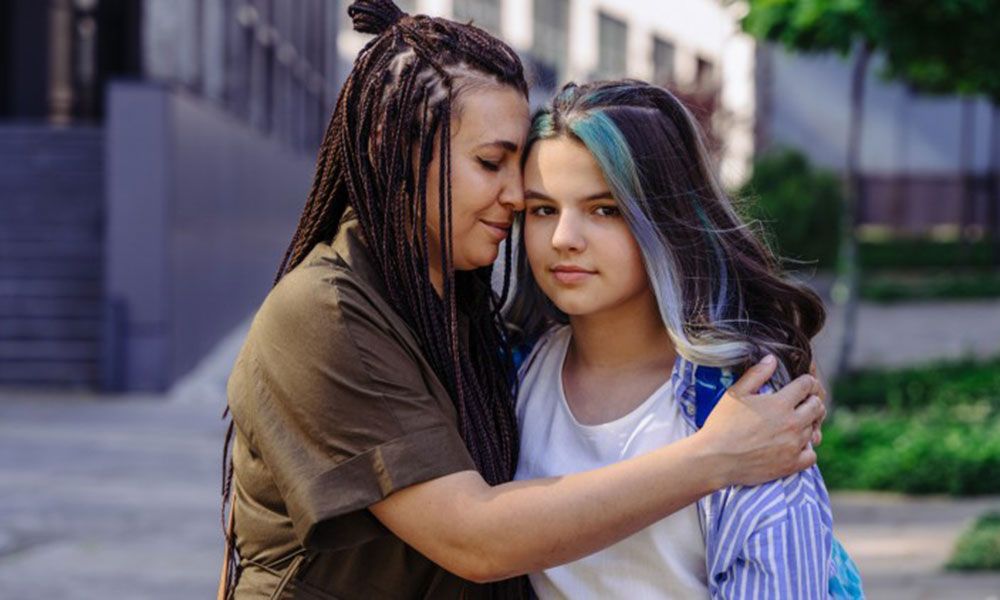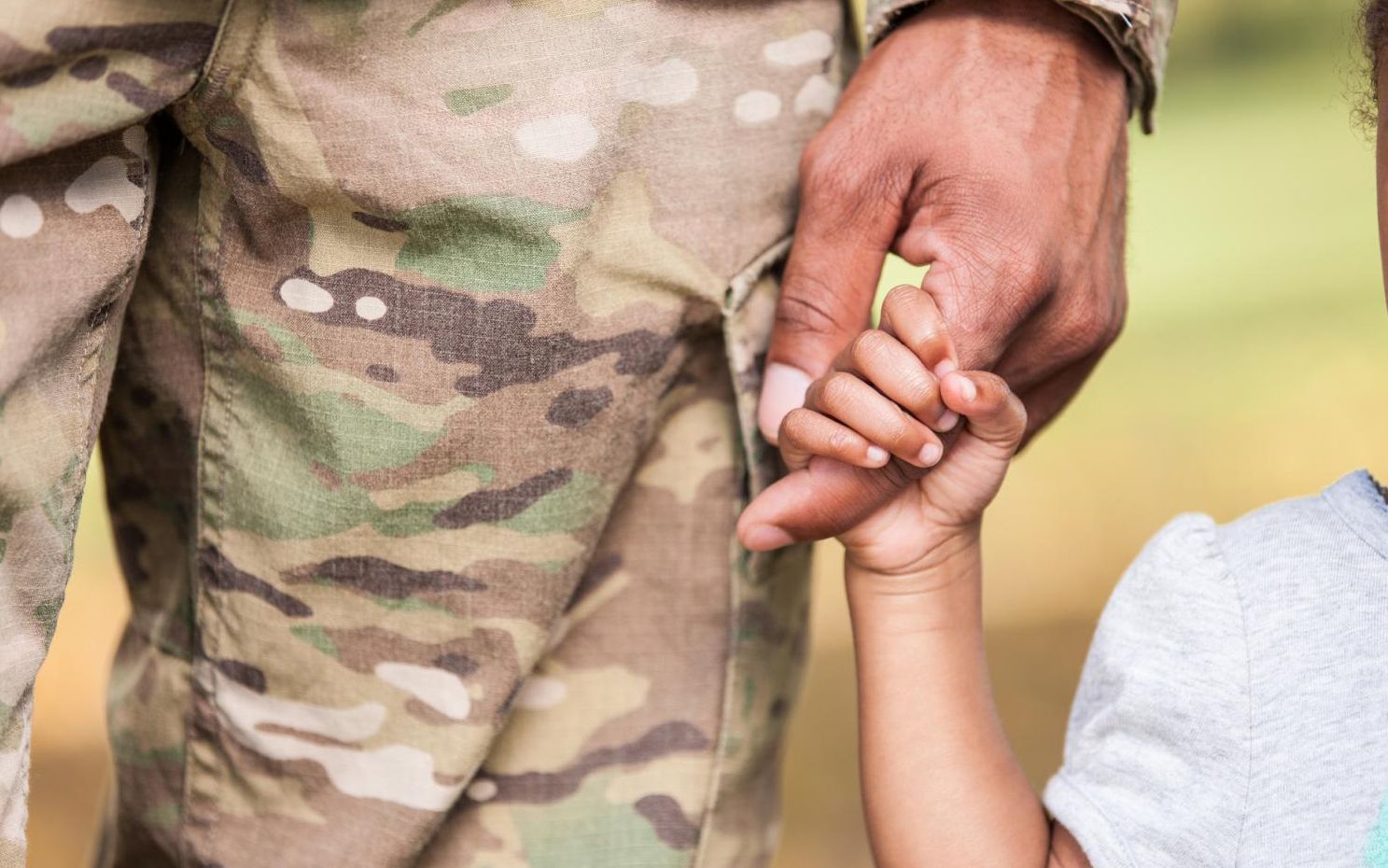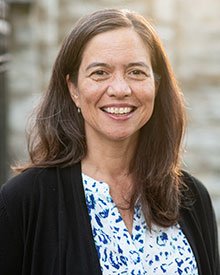New action guides to foster success in community prevention coalitions
Q&A with Sarah Chilenski, research professor of health and human development

Research Professor Sarah Chilenski leads the introductions for a panel discussion
Community prevention coalitions face many challenges in their work, but Penn State Research Professor Sarah Chilenski is leading the development of the Evidence2Success® Action Guides, which offer tips for success in community change work, drawing from the experiences of six U.S. communities. Photo credit: Matt Fern/Phase 7 Design
July 16, 2024
By Grace Strayer and Sara Brennen
UNIVERSITY PARK, Pa. — Community prevention coalitions form when individuals or organizations come together to accomplish a common goal, such as preventing adolescent substance use or promoting health and well-being. However, coalitions are often faced with challenges such as assessing community and coalition needs, figuring out how to engage strategic partners, and creating sustained long-term funding.
To aid community coalitions in tackling the complex tasks ahead of them, Penn State Research Professor Sarah Chilenski has partnered with the Annie E. Casey Foundation to create the Evidence2Success Action Guides. Evidence2Success is a framework developed by the foundation for engaging communities and public systems — such as school systems, social services, and juvenile justice — in improving the well-being of children and youth.
Over the past decade, Chilenski and her team have studied the six communities across the U.S. using Evidence2Success, collecting extensive data and building strong, collaborative relationships with leaders in those communities. Their work has led them to identify the themes most important to the success of community coalitions: data collection with youth, fiscal planning, bringing together community members, considering culture and context in prevention, and the importance of community participation and evidence-based program implementation. Each of these themes will be featured in an action guide for coalitions to download and use free of charge.
The first two action guides, “Using Data from a Youth Survey” and “Taking the Guesswork out of Funding Youth Programs,” are available online and the remaining three guides will be published later this year.
Chilenski said she hopes that new and established community coalitions nationwide will use the guides to enhance their impact on children and families. Below is her advice on how people can use them to benefit their communities.
Q: What do you see as the benefits of using these guides?
Chilenski: Community prevention coalitions can benefit from learning the “tricks of the trade” that can help them to be successful. Without having this kind of guidance, it would be like trying to cook your grandmother’s apple pie without her secret ingredient. That’s where we come in. We have learned so much from our evaluations across several years of working with different communities. These guides contain secrets to success for people doing community change work.
Q: How did you decide to focus on the five themes?
Chilenski: We have our partners at the Annie E. Casey Foundation to thank for identifying the themes. I think these surfaced as the most important for two reasons. First, the guides contain real, tangible tools, and those tools were considered core to the Evidence2Success work. Second, the themes are the ones that seemed to surface the most often in our work with coalitions.
The guides provide an archive of the lessons we learned through observing the communities we worked with over the years. People worldwide can access the action guides online.
Q: In addition to using the action guides, what advice would you give to someone who is looking to start a community coalition?
Chilenski: First and foremost — you need to know your community. You have to know the people and its history. Learn about what has succeeded and failed and what people think about it. Learn about existing resources, skills, and gaps before you start something new. It may be best not to start something new but to join forces with other pre-existing efforts. Then also, create that mission and vision, and don’t let the funding source dictate where you go and what you do. Make sure you are staying true to what your community needs and wants. It is about growing trust and building and sustaining relationships over time.
Q: How can one set of action guides accommodate different community coalitions?
Chilenski: The action guides aim to get to the core of experiences that are common among different coalition or community collaborative contexts. In our work, we have seen some foundational similarities across all coalitions. It’s true — every coalition is unique. These guides address how different coalitions can engage in the activities and use the tools within their context to support community change locally.
The six Evidence2Success communities were in different regions across the U.S.– in Rhode Island, Utah, Alabama, Tennessee and Florida. They had diverse racial and ethnic characteristics while sharing a higher poverty socio-economic context. Still, all are doing this work and making progress toward their goals. This gives us confidence that these tools will be relevant to many different types of coalitions or community collaborative change efforts.
We hope that when people from many different communities use them as a guide, they will see a path for themselves and their community to pursue the goals they have for their youth.
Q: What encouragement would you offer to community coalitions?
Chilenski: Community coalition work is long-haul work. Change can happen, but it takes time — years. It’s a lot of nitty-gritty planning, number crunching, and stepping beyond comfort zones. Knowing this and seeing the successes of those reaching goals a decade later can help coalitions adjust their expectations, stay hopeful, and dig into the hard work.
We hope these guides support and inspire coalitions, including those who don’t have the resources to hire an external consultant to help them. We also want communities to see that they are not alone; coalitions across the country with varying racial, ethnic, and socioeconomic characteristics have been doing and keep doing this work. Success is possible!
About the project
For more information about this project, contact Sarah Chilenski or Mary Lisa Penilla.
New action guides to foster success in community prevention coalitions
Q&A with Sarah Chilenski, research professor of health and human development

Research Professor Sarah Chilenski leads the introductions for a panel discussion
Community prevention coalitions face many challenges in their work, but Penn State Research Professor Sarah Chilenski is leading the development of the Evidence2Success® Action Guides, which offer tips for success in community change work, drawing from the experiences of six U.S. communities. Photo credit: Matt Fern/Phase 7 Design
July 16, 2024
By Grace Strayer and Sara Brennen
UNIVERSITY PARK, Pa. — Community prevention coalitions form when individuals or organizations come together to accomplish a common goal, such as preventing adolescent substance use or promoting health and well-being. However, coalitions are often faced with challenges such as assessing community and coalition needs, figuring out how to engage strategic partners, and creating sustained long-term funding.
To aid community coalitions in tackling the complex tasks ahead of them, Penn State Research Professor Sarah Chilenski has partnered with the Annie E. Casey Foundation to create the Evidence2Success Action Guides. Evidence2Success is a framework developed by the foundation for engaging communities and public systems — such as school systems, social services, and juvenile justice — in improving the well-being of children and youth.
Over the past decade, Chilenski and her team have studied the six communities across the U.S. using Evidence2Success, collecting extensive data and building strong, collaborative relationships with leaders in those communities. Their work has led them to identify the themes most important to the success of community coalitions: data collection with youth, fiscal planning, bringing together community members, considering culture and context in prevention, and the importance of community participation and evidence-based program implementation. Each of these themes will be featured in an action guide for coalitions to download and use free of charge.
The first two action guides, “Using Data from a Youth Survey” and “Taking the Guesswork out of Funding Youth Programs,” are available online and the remaining three guides will be published later this year.
Chilenski said she hopes that new and established community coalitions nationwide will use the guides to enhance their impact on children and families. Below is her advice on how people can use them to benefit their communities.
Q: What do you see as the benefits of using these guides?
Chilenski: Community prevention coalitions can benefit from learning the “tricks of the trade” that can help them to be successful. Without having this kind of guidance, it would be like trying to cook your grandmother’s apple pie without her secret ingredient. That’s where we come in. We have learned so much from our evaluations across several years of working with different communities. These guides contain secrets to success for people doing community change work.
Q: How did you decide to focus on the five themes?
Chilenski: We have our partners at the Annie E. Casey Foundation to thank for identifying the themes. I think these surfaced as the most important for two reasons. First, the guides contain real, tangible tools, and those tools were considered core to the Evidence2Success work. Second, the themes are the ones that seemed to surface the most often in our work with coalitions.
The guides provide an archive of the lessons we learned through observing the communities we worked with over the years. People worldwide can access the action guides online.
Q: In addition to using the action guides, what advice would you give to someone who is looking to start a community coalition?
Chilenski: First and foremost — you need to know your community. You have to know the people and its history. Learn about what has succeeded and failed and what people think about it. Learn about existing resources, skills, and gaps before you start something new. It may be best not to start something new but to join forces with other pre-existing efforts. Then also, create that mission and vision, and don’t let the funding source dictate where you go and what you do. Make sure you are staying true to what your community needs and wants. It is about growing trust and building and sustaining relationships over time.
Q: How can one set of action guides accommodate different community coalitions?
Chilenski: The action guides aim to get to the core of experiences that are common among different coalition or community collaborative contexts. In our work, we have seen some foundational similarities across all coalitions. It’s true — every coalition is unique. These guides address how different coalitions can engage in the activities and use the tools within their context to support community change locally.
The six Evidence2Success communities were in different regions across the U.S.– in Rhode Island, Utah, Alabama, Tennessee and Florida. They had diverse racial and ethnic characteristics while sharing a higher poverty socio-economic context. Still, all are doing this work and making progress toward their goals. This gives us confidence that these tools will be relevant to many different types of coalitions or community collaborative change efforts.
We hope that when people from many different communities use them as a guide, they will see a path for themselves and their community to pursue the goals they have for their youth.
Q: What encouragement would you offer to community coalitions?
Chilenski: Community coalition work is long-haul work. Change can happen, but it takes time — years. It’s a lot of nitty-gritty planning, number crunching, and stepping beyond comfort zones. Knowing this and seeing the successes of those reaching goals a decade later can help coalitions adjust their expectations, stay hopeful, and dig into the hard work.
We hope these guides support and inspire coalitions, including those who don’t have the resources to hire an external consultant to help them. We also want communities to see that they are not alone; coalitions across the country with varying racial, ethnic, and socioeconomic characteristics have been doing and keep doing this work. Success is possible!
About the project
For more information about this project, contact Sarah Chilenski or Mary Lisa Penilla.
Related Projects
Related People
Related Projects
Related People











